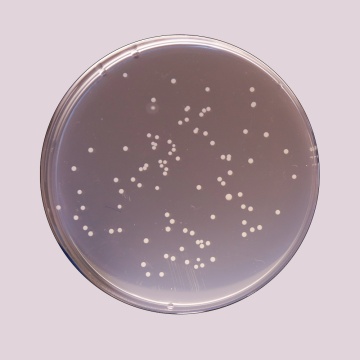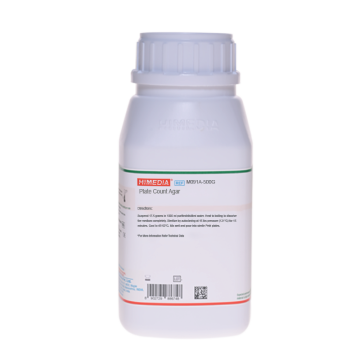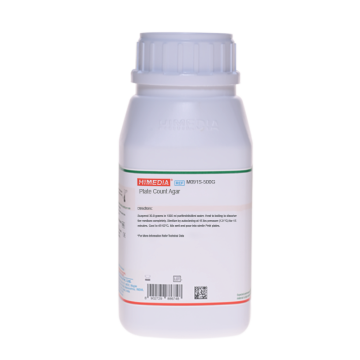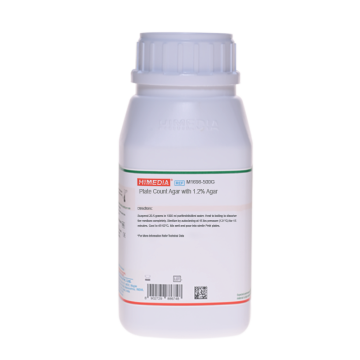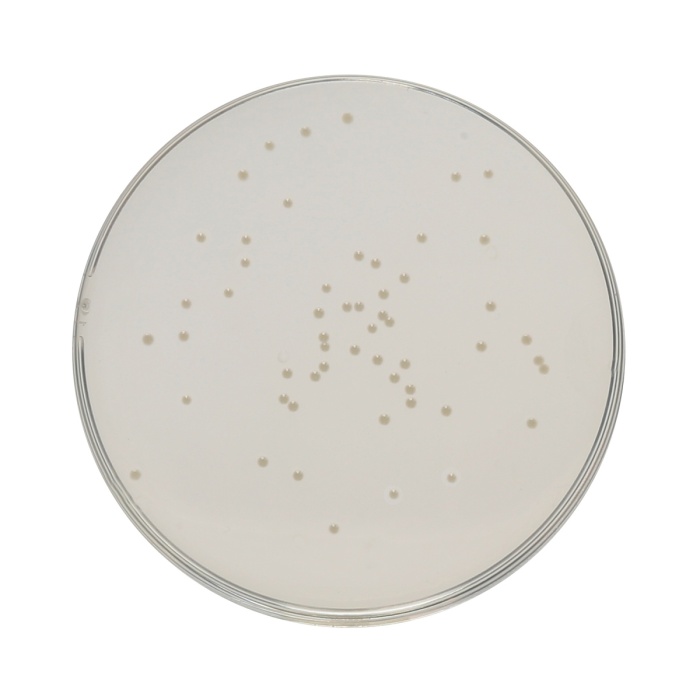 Your enquiry has been submitted
Your enquiry has been submitted
Plate Count Agar (Standard Methods Agar)
Psychrotrophic Microorganisms#CC293D
Intended use
Recommended for the determination of plate counts of microorganisms in food, water and wastewater.
Composition**
| Ingredients | g / L |
|---|---|
| Tryptone | 5.000 |
| Yeast extract | 2.500 |
| Dextrose (Glucose) | 1.000 |
| Agar | 15.000 |
Final pH (at 25°C): 7.0±0.2
**Formula adjusted, standardized to suit performance parameters
Directions
Suspend 23.5 grams in 1000 ml purified/distilled water. Heat to boiling to dissolve the medium completely. Sterilize by autoclaving at 15 lbs pressure (121°C) for 15 minutes. Cool to 45-50°C. Mix well and pour into sterile Petri plates.
Principle And Interpretation
Plate Count Agar is formulated as described by Buchbinder et al (1) which is recommended by APHA (2,3,4) and FDA (5). Tryptone provides nitrogenous and carbonaceous compounds, long chain amino acids, and other essential nutrients. Yeast extract supplies Vitamin B complex. APHA recommends the use of pour plate technique. The samples are diluted and appropriate dilutions are added in Petri plates. Sterile molten agar is added to these plates and plates are rotated gently to ensure uniform mixing of the sample with agar. The poured plate count method is preferred to the surface inoculation method, since it gives higher results. Plate Count Agar is also suitable for enumerating bacterial count of sterile rooms.
Type of specimen
Food and dairy samples; Water samples
Specimen Collection and Handling:
For food and dairy samples, follow appropriate techniques for sample collection and processing as per guidelines (3,4). For water samples, follow appropriate techniques for sample collection, processing as per guidelines and local standards (2). After use, contaminated materials must be sterilized by autoclaving before discarding.
Warning and Precautions :
Read the label before opening the container. Wear protective gloves/protective clothing/eye protection/ face protection. Follow good microbiological lab practices while handling specimens and culture. Standard precautions as per established guidelines should be followed while handling specimens. Safety guidelines may be referred in individual safety data sheets.
Limitations :
- Individual organisms differ in their growth requirement and may show variable growth patterns on the medium.
- Each lot of the medium has been tested for the organisms specified on the COA. It is recommended to users to validate the medium for any specific microorganism other than mentioned in the COA based on the user's unique requirement.
Performance and Evaluation
Performance of the medium is expected when used as per the direction on the label within the expiry period when stored at recommended temperature.
Quality Control
Appearance Cream to yellow granular media.
Gelling Firm, comparable with 1.5% Agar gel
Colour and Clarity of prepared medium Light yellow coloured clear to slightly opalescent gel forms in Petri plates
Reaction Reaction of 2.35% w/v aqueous solution at 25°C. pH: 7.0±0.2
Cultural Response
Cultural characteristics observed after an incubation at 35 - 37°C for 18-48 hours.
| Organism | Inoculum (CFU) | Growth | Recovery |
|---|---|---|---|
| ** Bacillus spizizenii ATCC 6633 (00003*) | 50-100 | luxuriant | >=70% |
| Enterococcus faecalis ATCC 29212 (00087*) | 50-100 | luxuriant | >=70% |
| Escherichia coli ATCC 25922 (00013*) | 50-100 | luxuriant | >=70% |
| Lactobacillus rhamnosus ATCC 9595 | 50-100 | luxuriant | >=70% |
| Staphylococcus aureus subsp. aureus ATCC 25923 (00034*) | 50-100 | luxuriant | >=70% |
| Streptococcus pyogenes ATCC 19615 | 50-100 | luxuriant | >=70% |
Key: *Corresponding WDCM numbers. **Formerly known as Bacillus subtilis subsp. spizizenii
Storage and Shelf Life
Store between 10-30°C in a tightly closed container and the prepared medium at 20-30°C. Use before expiry date on the label. On opening, product should be properly stored dry, after tightly capping the bottle inorder to prevent lump formation due to the hygroscopic nature of the product. Improper storage of the product may lead to lump formation. Store in dry ventilated area protected from extremes of temperature and sources of ignition Seal the container tightly after use. Product performance is best if used within stated expiry period.
Disposal
User must ensure safe disposal by autoclaving and/or incineration of used or unusable preparations of this product. Follow established laboratory procedures in disposing of infectious materials and material that comes into contact with sample must be decontamination and disposed of in accordance with current laboratory techniques (6,7).
Reference
- Buchbinder L., Baris Y., Aldd E., Reynolds E., Dilon E., Pessin V., Pincas L. and Strauss A., 1951, Publ. Hlth. Rep., 66:327.
- Lipps WC, Braun-Howland EB, Baxter TE,eds. Standard methods for the Examination of Water and Wastewater, 24th ed. Washington DC:APHA Press; 2023.
- Salfinger Y., and Tortorello M.L., 2015, Compendium of Methods for the Microbiological Examination of Foods, 5th Ed., American Public Health Association, Washington, D.C.
- Wehr H. M. and Frank J. H., 2004, Standard Methods for the Microbiological Examination of Dairy Products, 17th Ed., APHA Inc., Washington, D.C.
- FDA Bacteriological Analytical Manual, 2005, 18th Ed., AOAC, Washington, DC.
- Isenberg, H.D. Clinical Microbiology Procedures Handbook. 2nd Edition.
- Jorgensen, J.H., Pfaller, M.A., Carroll, K.C., Funke, G., Landry, M.L., Richter, S.S and Warnock., D.W.(2015) Manual of Clinical Microbiology, 11th Edition. Vol. 1.
| Product Name | Plate Count Agar (Standard Methods Agar) |
|---|---|
| SKU | M091 |
| Product Type | Regular |
| Physical Form | Powder |
| Origin | Animal |
| Packaging type | HDPE |
| References | 1. Buchbinder L., Baris Y., Aldd E., Reynolds E., Dilon E., Pessin V., Pincas L. and Strauss A., 1951, Publ. Hlth. Rep., 66:327. 2.Wehr H. M. and Frank J. H., 2004, Standard Methods for the Microbiological Examination of Dairy Products, 17th Ed.,APHA Inc., Washington, D.C. 3.Salfinger Y., and Tortorello M.L. Fifth (Ed.), 2015, Compendium of Methods for the Microbiological Examination ofFoods, 5th Ed., American Public Health Association, Washington, D.C. 4.Baird R.B., Eaton A.D., and Rice E.W., (Eds.), 2015, Standard Methods for the Examination of Water andWastewater, 23rd ed., APHA, Washington, D.C. 5.FDA Bacteriological Analytical Manual, 2005, 18th Ed., AOAC, Washington, DC. 6.Isenberg, H.D. Clinical Microbiology Procedures Handb0ook. 2nd Edition. 7.Jorgensen,J.H., Pfaller , M.A., Carroll, K.C., Funke, G., Landry, M.L., Richter, S.S and Warnock., D.W. (2015)Manual of Clinical Microbiology, 11th Edition. Vol. 1. |
| Customized Product Available | No |






